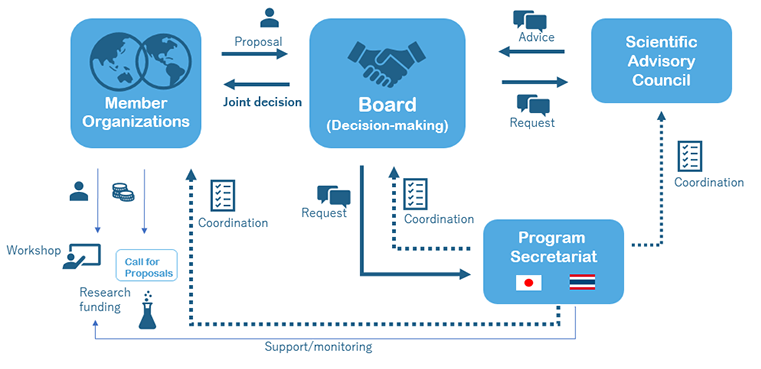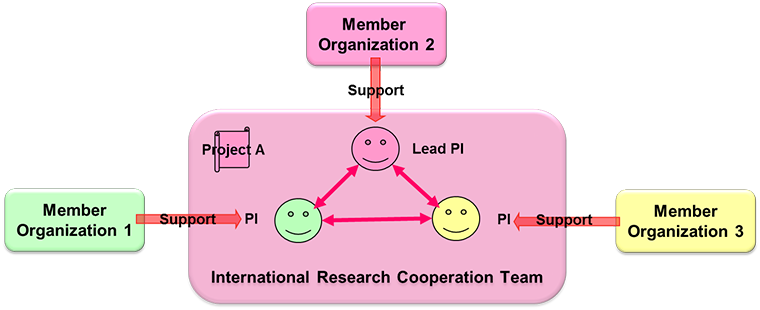General Description
- The East Asia Science and Innovation Area Joint Research Program, or e-ASIA JRP, is a multilateral international joint initiative between a number of public funding organizations of the East Asia Summit (EAS) member countries*.
* EAS members include: 10 ASEAN member countries and 8 additional countries (Australia, Japan, New Zealand, China, India, South Korea, Russia, U.S.) (EAS participating countries) - e-ASIA JRP works to formulate and support international joint research in the East Asian region on a multilateral basis as well as promoting researcher community exchange through workshops and other activities. Research projects are selected through open calls for proposals and subsequently supported by “Co-funding”.
- The idea of e-ASIA JRP was initially proposed at the 5th East Asia Summit in Hanoi in 2010, after which its implementation was formulated at the 1st e-ASIA Joint Research Forum in Singapore in 2011, followed by a formal inauguration of the program on June 28, 2012.
- To develop a vibrant and collaborative research community in science and technology, promote innovation in the East Asian region, and contribute to the economic development in the region.
- To realize synergistic effects through multilateral cooperation.
- To establish and develop equal partnerships.

A minimum of Member Organizations from three different countries agree to launch a joint call for proposals in one or several specific field(s) and submit Letters of Intent (LOIs) to the Program Secretariat including their funding commitment to the call. Each participating Member Organization decides whether or not to participate on a call-by-call basis.
A project consortium must include research teams from at least three different countries whose Member Organizations are participating in the call. Each individual research team must be led by a Principal Investigator (PI), and each consortium must be led by a Lead Principal Investigator (Lead PI), selected among the PIs. The Lead PI will submit a joint proposal on behalf of the entire consortium to the Program Secretariat. Each PI also needs to adhere to the rules and regulations of the Member Organization of his/her country.
After closing the call, the Program Secretariat forwards the proposals to the relevant Member Organizations. Each Member Organization receives only proposals which include researchers from its own country.
Each Member Organization creates its own ranking of submitted proposals through its own review process. Subsequently, all the participating Member Organizations convene and hold a Joint Review Meeting in which they discuss and produce a final candidate proposal list.
The Program Secretariat submits the final candidate proposal list to the Board, which will then formally approve the project(s) based on the Review Meeting’s recommendation.
Upon approval, the Program Secretariat announces the results to each applicant after which each Member Organization provides funding to researchers in its own country. In principle, funds do not cross borders.

Member Organizations of each country (three or more) participating in the call fund their own researchers in a co-funding process. Financial support up to approximately 350,000USD is granted to each project to cover a three-year period (including overhead expenses) and may in some cases be in the form of in-kind support depending on the budget situation of relevant Member Organizations. The amount may vary between each participating Member Organization but should be roughly equivalent to allow for researchers in each country to adequately conduct joint research. The amount and period of support is determined flexibly through coordination between the Member Organizations.
New organizations are elected to e-ASIA JRP membership at program board meetings. Organizations eligible for membership of the Program include ministries, agencies and other public and governmental bodies* which provide research funding in EAS participating countries. Program membership is free and participating in program activities is voluntary.
*This includes public organizations principally funded by the national government of eligible countries, not including private companies, foundations, charities, etc.
Prospective Member Organizations should refer to the “Guidelines for the Participation of New Member Organizations in the e-ASIA Joint Research Program” for more information.
A prospective Member Organization who accepts the stipulation detailed in the Program Statute submits a Letter of Intent for participation in the Program to the Program Secretariat from an official with authority over partnerships. Subsequently, the Program Secretariat will respond to the request and work with Member Organizations to hold the board meeting in order to be formally approved for membership.
Once membership has been approved, the organization is invited to board meetings and can propose themes for calls for proposals and join all the activities of the Program.
